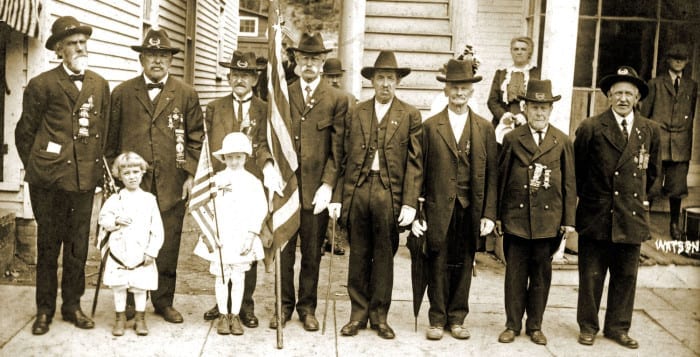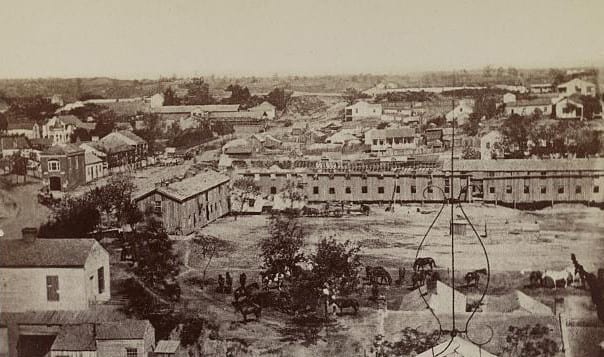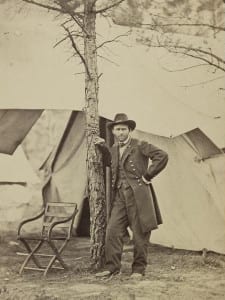By Rita J. Egan
This year marks the 150th anniversary of the end of the American Civil War, and to commemorate the sesquicentennial, the Northport Historical Society is hosting the exhibit Northport and the Civil War: A Few Good Men. Visitors to the historical society’s museum can follow the lives of 12 Northport men from when they mustered in until the war ended for them.
The historical society joins other organizations in the township of Huntington hosting Civil War events. Both historical society Director Heather Johnson and Terry Reid, consultant to the collections and member of the exhibit’s committee, said when town representatives first approached the organization about hosting an exhibit they were a bit hesitant. They admitted they weren’t confident if they could pull together a full exhibit since they weren’t aware of many Civil War artifacts in their collection. However, Reid said once the committee started culling through items, they found muster rolls with very detailed information about young men from Northport who fought in the war.
The consultant said the muster rolls not only include information about what battles the young men fought in but also if they were injured, their eye color and hair color, names of their parents and occupations. With the discovery of the muster rolls, Reid said the exhibit became a possibility as the committee began writing the stories of each man.
“I thought that here are these men we can focus on, telling their specific stories. So we did it as more of a storybook as opposed to here’s a bullet,” Reid said.
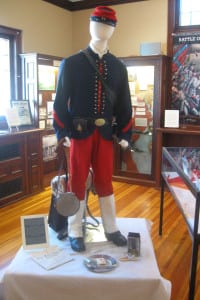
The committee, which in addition to Reid includes Candy Hamilton, Christine Doll-Wagner, Rhoda Wright and Darcy Little, then set out to find the artifacts to complement the stories. An email was sent out to members of the historical society asking if anyone owned memorabilia. Chris Cierski and Ben Meyburg, Civil War enthusiasts, stepped forward to lend some of the pieces from their collections, including a uniform Meyburg has used in reenactments.
Reid said once the society had artifacts to illustrate the men’s stories the exhibit really came together. Visitors to the museum will not only find photos and letters but also equipment the soldiers would have received such as canteens, belt buckles and guns.
Once the artifacts were in place, knowing that the men belonged to the 48th and 127th infantries, the consultant said the committee members were able to create maps for each cabinet to show the troops’ movements.
“One of our main goals in this whole exhibit was to get people to really stop and think what these men, these boys, did at their young age of 18, 19. They all enlisted and ran off to war immediately to help the cause. Unfortunately it didn’t end well for most of them,” Reid said.
The consultant said there are arrows on the floor to help visitors view the cases in order so that they can follow each soldiers’ journey in chronological order, and at the end, find out their fate.
“It was a very bloody, awful war, and the things they went through. . . . So, my heart was just breaking when I would read what happened to each one of them. I got emotionally attached to these boys. It was heartbreaking really to imagine what they must have gone through,” Reid said.
The exhibit also touches on the contributions the survivors made to Northport after their discharges such as Alfred C. Tillotson who owned a dry goods store on Main Street in the village.
The subject of whether a soldier will return from war is one that Johnson said she believes still strongly resonates with people.
“The idea of coming home, or unfortunately not coming home, it’s been going on since war began and continues to go on, unfortunately. I think because of that though it’s a universal theme. It’s something that we can all relate to even if you haven’t anyone really close to you or in your family who has fought in a war, you probably know someone who has or at least feel for those who are currently fighting,” Johnson said.
The director said visitors will find many interesting items on display including a metal heel plate with a shamrock cutout that Irish soldiers would use on their boots. Johnson said when she saw it she was touched by the fact that despite the horrors they faced, the soldiers still enjoyed some whimsy.
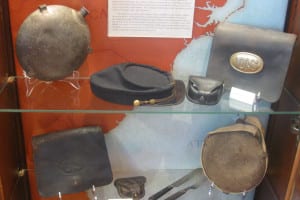
Johnson said visitors will also find letters from Francis Sammis to a friend in Northport. The solider wrote about his memories of the girls in Northport and the get-togethers the young people would have.
“He’s still a young man. He may be a soldier and he may be fighting in a horrible, horrible war, but he’s still thinking about those good times. Similar to what a young man might do today,” the director said.
Both Johnson and Reid hope visitors will take the time out to experience each of the soldiers’ stories and that it will have the same impact on guests as it did on them. Johnson said while everyone at the historical society learned a lot, she said she noticed the biggest impact on Reid.
“Terry in particular became very connected to those soldiers. She had read enough about them and it took on a different meaning for her,” Johnson said.
Reid said she found herself feeling protective in a motherly way of the young men as the committee discovered more about each of them.
“I hope that other people will come away the same way, will have the same sort of change as well. How could you not after you see these men’s faces,” she said.
Northport and the Civil War: A Few Good Men will be on view at the Northport Historical Society, 215 Main Street, until the end of the year. For more information, visit www.northporthistorical.org or call 631-757-9859.

